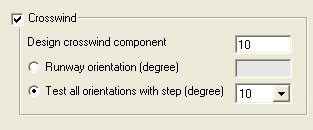WindRose PRO Help
by Enviroware srl
Crosswind and runway orientation
A crosswind is any wind that is blowing perpendicular to a direction.
In aviation, a crosswind is the component of wind that is blowing across the runway making a landing more difficult than if the wind were blowing straight down the runway. If a crosswind is strong enough it may exceed an aircraft's crosswind limit and an attempt to land under such conditions could cause structural damage to the aircraft.
Crosswinds can also occur when traveling on roads, especially on large bridges and highways, which can be dangerous for motorists because of possible lift force created as well as causing the vehicle to change direction of travel.
Each aircraft has a uniquely stated maximum crosswind component derived from flight test experiments. For example a Boeing 727-200 has a maximum crosswind component of 35 knots, while a Cessna 172 has a maximum crosswind component of 17 knots.
According to the Federal Aviation Administration (FAA AC 150/5300-13) a runway orientation must satisfy 95% coverage considering yearly wind conditions. This means that for the 95% of the time, the crosswind component must be smaller than the maximum crosswind component of the aicrafts landing in such airport.
WindRose PRO can be used for calculating crosswinds and to evaluate the correct orientation of a runway. It is also possible to find the best orientation for a new runway.

Click the Crosswind check box, then specify a designed, or maximum, crosswind component, using the same units of the wind data loaded in WindRose PRO.
If you want to evaluate the correct orientation of an existing runway, check the Runway orientation radio button and specify the orientation in degree. Note that the orientation goes from the specified angle to it plus 180. For example an orientation of 45 degrees means a runway from NE to SW, while an orientation od 225 degrees means a runway from SW to NE.
If you want to determine the best orientation of a runway, check the Test all orientations radio button and specify the angular step which will be applied starting from 0 degrees. For example an angular step fo 10 degrees means that 36 runway orientations will be examined: 0, 10, 20, ..., 350.
The output will contain information about the percentage of time above and below the design crosswind component, the maximum crosswind from left and right, the maximum headwind and the maximum tailwind.
Since WindRose PRO allows to filter the input data according to date and time, it is possible to evaluate the crosswind component even for airports which work only in particular seasons (for example during summer) or only during day time.
This analysis is not available when data are loaded as frequencies.
In aviation, a crosswind is the component of wind that is blowing across the runway making a landing more difficult than if the wind were blowing straight down the runway. If a crosswind is strong enough it may exceed an aircraft's crosswind limit and an attempt to land under such conditions could cause structural damage to the aircraft.
Crosswinds can also occur when traveling on roads, especially on large bridges and highways, which can be dangerous for motorists because of possible lift force created as well as causing the vehicle to change direction of travel.
Each aircraft has a uniquely stated maximum crosswind component derived from flight test experiments. For example a Boeing 727-200 has a maximum crosswind component of 35 knots, while a Cessna 172 has a maximum crosswind component of 17 knots.
According to the Federal Aviation Administration (FAA AC 150/5300-13) a runway orientation must satisfy 95% coverage considering yearly wind conditions. This means that for the 95% of the time, the crosswind component must be smaller than the maximum crosswind component of the aicrafts landing in such airport.
WindRose PRO can be used for calculating crosswinds and to evaluate the correct orientation of a runway. It is also possible to find the best orientation for a new runway.

Click the Crosswind check box, then specify a designed, or maximum, crosswind component, using the same units of the wind data loaded in WindRose PRO.
If you want to evaluate the correct orientation of an existing runway, check the Runway orientation radio button and specify the orientation in degree. Note that the orientation goes from the specified angle to it plus 180. For example an orientation of 45 degrees means a runway from NE to SW, while an orientation od 225 degrees means a runway from SW to NE.
If you want to determine the best orientation of a runway, check the Test all orientations radio button and specify the angular step which will be applied starting from 0 degrees. For example an angular step fo 10 degrees means that 36 runway orientations will be examined: 0, 10, 20, ..., 350.
The output will contain information about the percentage of time above and below the design crosswind component, the maximum crosswind from left and right, the maximum headwind and the maximum tailwind.
Since WindRose PRO allows to filter the input data according to date and time, it is possible to evaluate the crosswind component even for airports which work only in particular seasons (for example during summer) or only during day time.
This analysis is not available when data are loaded as frequencies.
Introduction:
Basics:
- System requirements
- Installation
- License agreement
- Ordering information
- Download
- Evaluation
- Registration
- Support and questions
- Technical warranty
Tutorial:
- Graphical interface
- Load
- Comma separated values
- Excel files
- AERMOD files
- ISC3ST files
- ASCII files
- EnergyPlus Weather
- Frequencies
- Analyse
- Draw
- Chart
- Copy
- Output
- Excel
- DXF
- KML
- SHP
- Save
- Options
- About
- Help
- Quit
- Check for updates